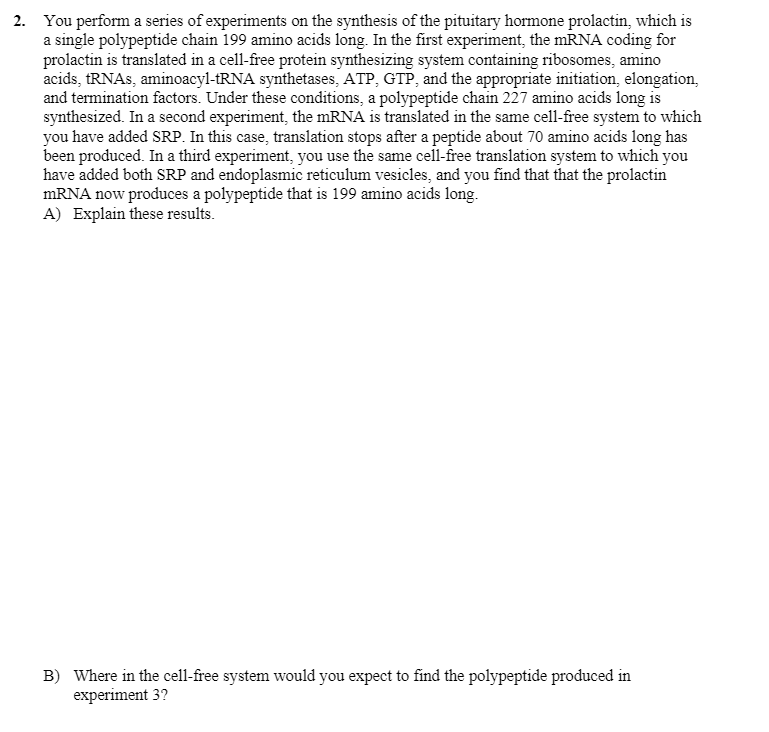You perform a series of experiments on the synthesis of the pituitary hormone prolactin, which is a single polypeptide chain 199 amino acids long. In the first experiment, the mRNA coding for prolactin is translated in a cell-free protein synthesizing system containing ribosomes, amino acids, RNAS, aminoacyl-tRNA synthetases, ATP, GTP, and the appropriate initiation, elongation, and termination factors. Under these conditions, a polypeptide chain 227 amino acids long is synthesized. In a second experiment, the mRNA is translated in the same cell-free system to which you have added SRP. In this case, translation stops after a peptide about 70 amino acids long has been produced. In a third experiment, you use the same cell-free translation system to which you have added both SRP and endoplasmic reticulum vesicles, and you find that that the prolactin MRNA now produces a polypeptide that is 199 amino acids long. A) Explain these results. B) Where in the cell-free system would you expect to find the polypeptide produced in experiment 3?
You perform a series of experiments on the synthesis of the pituitary hormone prolactin, which is a single polypeptide chain 199 amino acids long. In the first experiment, the mRNA coding for prolactin is translated in a cell-free protein synthesizing system containing ribosomes, amino acids, RNAS, aminoacyl-tRNA synthetases, ATP, GTP, and the appropriate initiation, elongation, and termination factors. Under these conditions, a polypeptide chain 227 amino acids long is synthesized. In a second experiment, the mRNA is translated in the same cell-free system to which you have added SRP. In this case, translation stops after a peptide about 70 amino acids long has been produced. In a third experiment, you use the same cell-free translation system to which you have added both SRP and endoplasmic reticulum vesicles, and you find that that the prolactin MRNA now produces a polypeptide that is 199 amino acids long. A) Explain these results. B) Where in the cell-free system would you expect to find the polypeptide produced in experiment 3?
Biology: The Dynamic Science (MindTap Course List)
4th Edition
ISBN:9781305389892
Author:Peter J. Russell, Paul E. Hertz, Beverly McMillan
Publisher:Peter J. Russell, Paul E. Hertz, Beverly McMillan
Chapter15: From Dna To Protein
Section: Chapter Questions
Problem 5TYK: Which of the following statements is false? a. GTP is an energy source during various stages of...
Related questions
Question
Need B

Transcribed Image Text:2. You perform a series of experiments on the synthesis of the pituitary hormone prolactin, which is
a single polypeptide chain 199 amino acids long. In the first experiment, the mRNA coding for
prolactin is translated in a cell-free protein synthesizing system containing ribosomes, amino
acids, TRNAS, aminoacyl-tRNA synthetases, ATP, GTP, and the appropriate initiation, elongation,
and termination factors. Under these conditions, a polypeptide chain 227 amino acids long is
synthesized. In a second experiment, the mRNA is translated in the same cell-free system to which
you have added SRP. In this case, translation stops after a peptide about 70 amino acids long has
been produced. In a third experiment, you use the same cell-free translation system to which you
have added both SRP and endoplasmic reticulum vesicles, and you find that that the prolactin
MRNA now produces a polypeptide that is 199 amino acids long.
A) Explain these results.
B) Where in the cell-free system would you expect to find the polypeptide produced in
experiment 3?
Expert Solution
This question has been solved!
Explore an expertly crafted, step-by-step solution for a thorough understanding of key concepts.
This is a popular solution!
Trending now
This is a popular solution!
Step by step
Solved in 3 steps

Knowledge Booster
Learn more about
Need a deep-dive on the concept behind this application? Look no further. Learn more about this topic, biology and related others by exploring similar questions and additional content below.Recommended textbooks for you

Biology: The Dynamic Science (MindTap Course List)
Biology
ISBN:
9781305389892
Author:
Peter J. Russell, Paul E. Hertz, Beverly McMillan
Publisher:
Cengage Learning

Biology 2e
Biology
ISBN:
9781947172517
Author:
Matthew Douglas, Jung Choi, Mary Ann Clark
Publisher:
OpenStax

Biology: The Dynamic Science (MindTap Course List)
Biology
ISBN:
9781305389892
Author:
Peter J. Russell, Paul E. Hertz, Beverly McMillan
Publisher:
Cengage Learning

Biology 2e
Biology
ISBN:
9781947172517
Author:
Matthew Douglas, Jung Choi, Mary Ann Clark
Publisher:
OpenStax